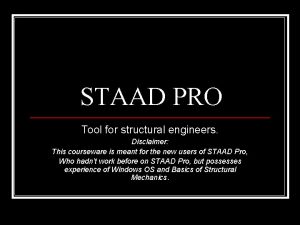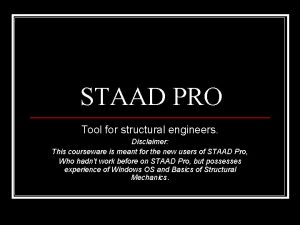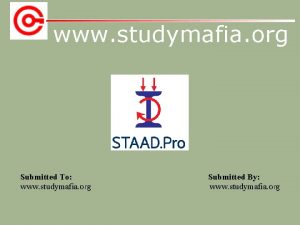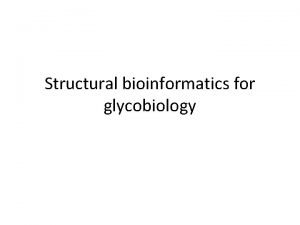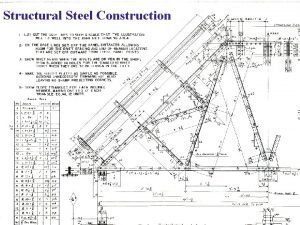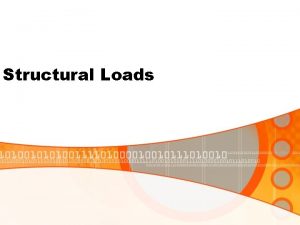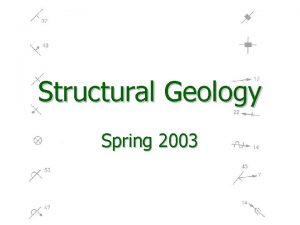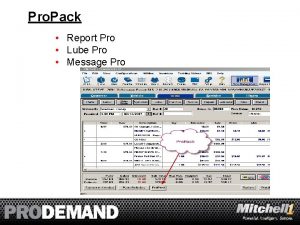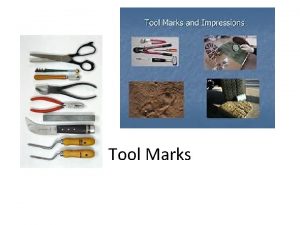STAAD PRO Tool for structural engineers Disclaimer This












- Slides: 12

STAAD PRO Tool for structural engineers. Disclaimer: This courseware is meant for the new users of STAAD Pro, Who hadn’t work before on STAAD Pro, but possesses experience of Windows OS and Basics of Structural Mechanics.

Topics Theory + Practical n n n History of Staad Pro How does Staad Pro Analyse? Basic types of structures Creating the geometry using different methods Use more advanced technique in creating geometry Defining the Cross-Sections of Beams, Columns, Plates Defining the Constants, Specifications, and Supports Defining the Load Systems Analyzing your Model using the appropriate Analysis method Reviewing the Analysis Results Performing Concrete Design Performing Steel Design

History of Staad Pro Software n n n STAAD stands for STructural Analysis And Design – One of first commercial software in world STAAD-III for DOS – non-graphical software REI & QSE merged –Analysis engine + Interface = STAAD PRO for windows. Sharing capabilities with other major software like Auto. CAD, and MS Excel Reports of the inputs and the outputs Concrete and steel design

Understand STAAD Pro way of doing the job n n n One of the most famous analysis methods to analyze continuous beams is “Moment Distribution Method”, which is based on the concept of transferring the loads on the beams to the supports at their ends. Each support will take portion of the load according to its K; K is the stiffness factor, which equals EI/L. As you can see E, and L is constant per span, the only variable here is I; moment of inertia. I depends on the cross section of the member. So, if you want to use this analysis method, you have to assume a cross section for the spans of the continuous beam. If you want to use this method to analyze a simple frame, it will work, but it will not be simple, and if you want to make the frame a little bit more complicated (simple 3 D frame) this method alls short to accomplish the same mission. Hence, a new more sophisticated method emerged, which depends fully on matrices, this method called “Stiffness Matrix Method”, the main formula of this method is: [P] = [K] x [Δ] [P] is the force matrix = Dead Load, Live Load, Wind Load, etc [K] is the stiffness factor matrix. = K=EI/L [Δ] is the displacement matrix

Stiffness Method n The stiffness analysis implemented in STAAD is based on the matrix displacement method. n In the matrix analysis of structures by the displacement method, the structure is first idealized into an assembly of discrete structural components (frame members or finite elements). Each component has an assumed form of displacement in a manner which satisfies the force equilibrium and displacement compatibility at the joints n First structural software which adopted Matrix Methods for the method of analysis was STAAD n Methods used : - Modified Cholesky’s method (Decomposition) Most efficient accurate and time saving method also well suited for Gaussian Elimination Process

Types of Structures A STRUCTURE can be defined as an assemblage of elements. STAAD is capable of analyzing and designing structures consisting of both frame, and Finite elements. Almost any type of structure can be analyzed by STAAD. n Frame elements – Beam elements – 2 nodes n Finite elements – 1. ) Plate – 3 or 4 nodes 2. ) Solid – 4 to 8 nodes Remember for staad Node becomes Joint it has a number and xyz cordinates Beam becomes Member it has a number and nodes at its ends Plate becomes Element it has a number and node at its corners n

Continue… n A TRUSS structure consists of truss members which can have only axial member forces and no bending in the members n A PLANE structure is bound by a global X-Y coordinate system with loads in the same plane n A SPACE structure, which is a three dimensional framed structure with loads applied in any plane, is the most general. n A FLOOR structure is a two or three dimensional structure having no horizontal (global X or Z) movement of the structure [FX, FZ & MY are restrained at every joint]. The floor framing (in global X-Z plane) of a building is an ideal example of a FLOOR structure. Columns can also be modeled with the floor in a FLOOR structure as long as the structure has no horizontal loading. If there is any horizontal load, it must be analyzed as a SPACE structure.

Continue. .

Coordinate Systems

Working Method In order to build up a good input file we have to understand STAAD Pro way. This procedure will enable us to: n n n Organize our thoughts. Put each step in its right position, not before, and not after. Make sure that all of the STAAD Pro commands are present in the input file (none of them is overlooked). Provide us with speedy and guaranteed way to create the input file. Avoid error messages.

Check - Change Input Geometry –Nodes, Beams, Plates Input Properties Input Specs, Constant, Supports Input Loading System Specify Analysis Type Run Analysis View and Verify Results Design Verify

Shall we proceed to Practical Part?
 Staad pro tools
Staad pro tools Macro pro
Macro pro Potter's wheel data cleaning tool
Potter's wheel data cleaning tool Ledningssystem för verksamhetsinformation
Ledningssystem för verksamhetsinformation Formel gruplar
Formel gruplar Datorkunskap för nybörjare
Datorkunskap för nybörjare Tack för att ni har lyssnat
Tack för att ni har lyssnat Läkarutlåtande för livränta
Läkarutlåtande för livränta Klassificeringsstruktur för kommunala verksamheter
Klassificeringsstruktur för kommunala verksamheter Returpilarna
Returpilarna Påbyggnader för flakfordon
Påbyggnader för flakfordon Tack för att ni lyssnade
Tack för att ni lyssnade Egg för emanuel
Egg för emanuel
